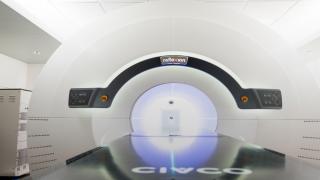City of Hope continues to change the cancer treatment paradigm by leaning into available technology and adopting and applying it in innovative ways to care for its patients.
It was only the second institution in the world to begin using a novel radiation machine called RefleXion X1, which allows radiation oncologists to see more tumors throughout the body and specifically target them with radiation while minimizing exposure that can damage surrounding tissue.
BgRT Radiation Therapy
More recently, City of Hope made history again by successfully treating its first patient using the RefleXion X1 machine and applying SCINTIX biology-guided radiation therapy, or BgRT. This is a novel and innovative form of radiation delivery that uses a signal generated by positron emission tomography (PET) to guide external beam radiation therapy. It is a technology breakthrough that uses live, continuously updated data throughout the entire treatment session to determine exactly where to deliver radiotherapy to biologically active tumors.
“What we want to do is shape the beam, so the tumor gets high dosage but the area around it does not,” explained An Liu, Ph.D., clinical professor of radiation oncology. “The more degrees of freedom we have, the better we can do that, and RefleXion and SCINTIX create that landscape and opportunity.”
A Technology Evolution

“Using the PET signal may allow us to reduce the beam field size, allowing our radiation oncology team to reduce toxicity and avoid the need to manage motion,” added Terence Williams, M.D., Ph.D., chair of radiation oncology.
“This technology is evolving,” he said. “Eventually, it may also allow us to more comprehensively treat patients with many metastases throughout the body for more complete metastatic ablation.” Williams said with this first BgRT patient, City of Hope joined the ranks of the National Cancer Institute-designated comprehensive cancer centers at Stanford University and the University of Texas-Southwestern in being the first institutions in the world to use RefleXion SCINTIX technology. City of Hope was the third institution to adopt this new technology and install the equipment, just behind Stanford and UT Southwestern, and second after Stanford to begin treating patients.
Radiation oncologist Sagus Sampath, M.D., medical director for Duarte Radiation Oncology, is the attending physician for the first BgRT patient, a 65-year-old lung cancer patient who came to City of Hope late last year.
Using SCINTIX Technology on Metastatic Cancer

The patient was “newly diagnosed and came to us with his primary tumor in the left lung and a single metastasis in his left femur,” Sampath said. “We opted to treat the femur first and offered the patient a PET scan to see if he might be eligible for the SCINTIX technology.”
The PET scan confirmed a higher PET signal, or “bright spot,” associated with the left femur metastasis, signaling the presence of cancer cells that could be treated with a potentially more precise, biologically targeted radiation approach.
“It was that bright spot that caught my eye,” Sampath said. “The location of the metastasis within the femur made it feasible to offer a single fraction of treatment. This approach would also minimize any delays in starting my patient’s chemotherapy.”
Sampath explained that RefleXion X1 could zero in on the bright spot in the leg through its SCINTIX technology by using the tumor’s own “biological signature.”
The Novel Piece
“The RefleXion machine enabled us to use the patient’s own PET signal from the patient’s own tumor to define our approach to how we treat his cancer. That’s the novel piece of this. It was all about the patient’s biology from start to finish,” Sampath said.
With the femur radiation complete, the patient started a course of chemotherapy. He will be returning soon to start a course of concurrent chemotherapy and radiation to treat his primary lung tumor. Sampath said the radiation oncology team is encouraged that this latest success establishes a precedent that can pave the way for more patients to benefit from the BgRT approach.
“We have carried this one through and broken through the glass ceiling,” Sampath said. “We look forward to being able to offer this to more patients who can benefit from this leading-edge technology.”
An Important Milestone
Williams agreed that treating this first patient is an important milestone for City of Hope.
“Dr. An Liu and the rest of the physics team — in particular Drs. Chunhui Han and Tyler Watkins — have been working tirelessly to make this happen,” he said. “I’m also thankful to our Duarte physicians who have helped us identify eligible patients for this treatment, and to Drs. Sagus Sampath and Stephanie Yoon for taking such good care of this first patient. Kudos also to our dosimetry and radiation therapy technology teams for getting us to this first-patient goal.”
The patient’s successful treatment was very much a team effort, Sampath said, one that was “years in the making.”
“The success of completing our first BGRT stems from months of accumulating experience across our entire department, including our therapist, dosimetry, physics and physician teams,” Sampath said. “I would like to personally thank all my colleagues, especially my fellow physicians, for their critical contributions in helping our department reach this important breakthrough and turning point. “
Williams, Sampath and An all agreed that this first treatment marks the launch of a new era of radiation treatments and opens the door to a number of new clinical trials led by many physicians in the department, including Arya Amini, M.D., Jeffery Wong, M.D., Savita Dandapani, M.D., Ph.D., and many more.
Liu said achievements like this are all in service to City of Hope’s mission.
“The only way we can advance cancer cures is to be a pioneer in the field,” he said. “That’s who we are at City of Hope.”
